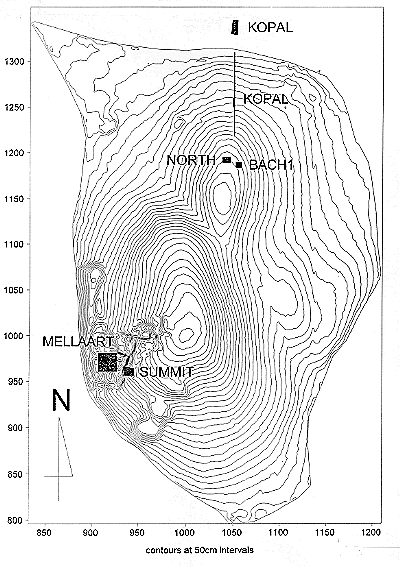EXCAVATIONS IN 1997
 In terms of other aspects of methodology we continued with the strategies of dry sieving all soil and wet sieving 30 litres from all units. The heavy residues from the latter were sieved through 4 mm, 2 mm, and 1 mm meshes and that sorted by hand by a team of up to 10 women from the local villages to whom we gave special training. The overall emphasis on integrated and reflexive research continued, with video documentation and diary writing acting as central components.
In terms of other aspects of methodology we continued with the strategies of dry sieving all soil and wet sieving 30 litres from all units. The heavy residues from the latter were sieved through 4 mm, 2 mm, and 1 mm meshes and that sorted by hand by a team of up to 10 women from the local villages to whom we gave special training. The overall emphasis on integrated and reflexive research continued, with video documentation and diary writing acting as central components.
One methodological change was that the 'specialist tours' which had caused problems in previous years were changed into 'priority tours'. The aim of the latter is to develop a form of sampling strategies. The trouble with pre-set sampling strategies is that they are not sensitive to the specific data being uncovered and they may not be adequate for all the different specialist interests. We decided that it was necessary to have some form of sampling strategy that was negotiated between the different project members, and was argued out in relation to the emerging interpretation of individual features. Thus, every two days representatives from all the lab teams toured the site and discussed the individual excavation areas with the digging teams. Each deposit was discussed and decisions made about whether it should be prioritised. Prioritised units would be those that would be studied by all specialist staff (bones, seeds, lithics etc) during the post-excavation process. In this way we could ensure that information from one type of analysis could be compared with another type of analysis. The priority tours also identified fast-track units. These latter units would be studied by the faunal, botanical, lithic, ceramic and small finds specialists before the next tour in two days time. During that tour the results of the preliminary analyses would be discussed and the overall interpretation of the deposit discussed with the digging staff. In this way immediate feedback could be provided for the digging staff, and further digging and sampling could be adjusted accordingly. This whole prioritising procedure proved very successful, partly thanks to the presence on site of our computer specialist, Anja Wolle, who was able to provide updated priority lists for all to work on, on a day to day basis.

The video documentation in progress in the Mellaart Area